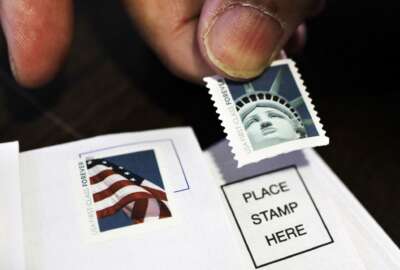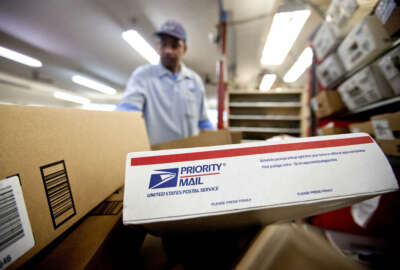
Postal Service looks to autumn for stamp price flexibility, more leadership
The U.S. Postal Service reported the latest in a series of financial setbacks on Thursday, but the agency may see some big changes coming this fall.
The U.S. Postal Service reported the latest in a series of financial setbacks on Thursday, but the agency may see some big changes coming this autumn.
The Postal Service reported a $2.1 billion loss for the third quarter of fiscal 2017, which is $573 million greater than its loss for the same period last fiscal year, and driven in part by higher transportation costs.
However, some good news for the Postal Service could be in the works. The Postal Regulatory Commission, an independent panel that oversees USPS, will conclude its 10-year review of the Postal Service’s rate-setting system this fall, possibly as early as September. The Associated Press on Wednesday reported the PRC will likely give postal management freedom to raise the cost of postage stamps beyond the rate of inflation. While regulators could set limits on higher postage rates, this would be the biggest change in the Postal Service’s pricing structure in decades.
“We’re clearly looking for the PRC to establish a new pricing system for us,” Postmaster General Megan Brennan said, during a conference call Thursday. “From a financial perspective, the Postal Service continues to face strong financial headwinds,” as first-class mail, the Postal Service’s most profitable product, continues to decline in volume.
USPS reported a $422 million decrease in first-class mail revenue this quarter compared to the same period last year.
“This year, we’re seeing an acceleration in first-class volume decline, so this dynamic puts even more financial pressure on the organization, given that first-class mail pays our bills and defines our network requirements,” Brennan said.
USPS also experienced an unexpected $150 million loss in marketing mail revenue — from items like weekly flyers and advertisements.
“This is a departure from the steady marketing mail volume trends we maintained over the last four years,” Chief Financial Officer Joseph Corbett said.
The Postal Service reported $473 million in revenue this quarter from lower-margin package delivery, an 11.3 percent increase from the same period last year.
The current cost of a first-class stamp is 49 cents. The PRC in April 2016 repealed a 2-cent exigent postal rate increase that had been in place since the 2008 recession, bringing the price of a stamp down to 47 cents, but had reversed that decision this January.
Fredric Rolando, president of the National Association of Letter Carriers, said the rollback of the exigent postal rate made “little financial sense,” and called on postal regulators to give the USPS more pricing flexibility for its products.
“The PRC has the ability to correct this mismatch and relieve the resulting financial pressure,” Rolando said in a statement.
USPS expects to see new governors on board this fall
Brennan continued to push for passage of a postal reform bill that made it out of the House Oversight and Government Reform Committee back in February. The bipartisan legislation would, among other things, introduce a 1-cent exigent rate increase for stamps and significantly reduce the burden of USPS’ current mandate from Congress to pre-fund postal retirees’ health benefits by automatically enrolling them in Medicare Part B.
The postmaster general also expressed optimism that President Donald Trump would soon submit nominees for the Postal Service’s board of governors. It currently has zero independently appointed governors on its board. The last member of the postal board stepped down in December 2016 after his term expired.
“We certainly have encouraged the administration to nominate and the Senate to confirm candidates to fill the vacancies, and we’re optimistic that we’ll see that process move and have governors nominated and confirmed by the fall,” Brennan said.
Without those governors at the helm, USPS does not have the authority to raise postage rates or introduce new products.
Rolling out next-generation vehicle fleet
The Postal Service also expects to begin testing of its next-generation of delivery vehicle fleet this fall.
“Given the change in the mail mix, we’re looking for improved safety enhancements, looking to reduce emissions and also to produce operational savings,” Brennan said. Five suppliers were awarded prime contracts in September 2016 to design prototypes.
Copyright © 2025 Federal News Network. All rights reserved. This website is not intended for users located within the European Economic Area.
Jory Heckman is a reporter at Federal News Network covering U.S. Postal Service, IRS, big data and technology issues.
Follow @jheckmanWFED
Related Stories





